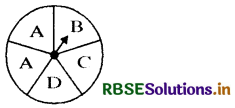RBSE Solutions for Class 8 Maths Chapter 5 Data Handling Ex 5.3
Rajasthan Board RBSE Solutions for Class 8 Maths Chapter 5 Data Handling Ex 5.3 Textbook Exercise Questions and Answers.
RBSE Class 8 Maths Solutions Chapter 5 Data Handling Ex 5.3
Question 1.
List the outcomes you can see in these experiments.
(a) Spinning a wheel
(b) Tossing two coins together

Answer:
(a) Outcomes in spinning a wheel are A, B, C and D.
(b) Possible outcomes are HH, HT, TH, TT [Here, HT means Head on first coin and Tail on the second coin]
Question 2.
When a die is thrown, list the outcomes of an event of getting
(i) (a) a prime number
(b) not a prime number.
(ii) (a) a number greater than 5
(b) a number not greater than 5.
Answer:
Possible outcomes are 1, 2, 3, 4, 5, or 6.
(i) (a) A prime number : 2, 3, 5
(b) Not a’prime number : 1, 4, 6
(ii) (a) a number greater than 5 is 6.
(b) a number not greater than 5 are 1, 2, 3, 4 and 5

Question 3.
Find the.
(a) Probability of the pointer stopping on D in (Question l-(a))?
(b) Probability of getting an ace from a well shuffled deck of 52 playing cards?
(c) Probability of getting a red apple. (See figure above)
Answer:
(a) Number of possible outcomes for pointer stopping on D = 1
Total number of outcomes of the experiment = 5
∴ Probability of the pointer stopping on D = \(\frac{1}{5}\)
(b) Number of possible outcomes = 52
No. of an ace in a pack of 52 cards = 4
∴ Probability of getting an ace = \(\frac{4}{52}\) = \(\frac{1}{13}\)
(c) Total no. of apples = 7
No. of red apples = 4
∴ Probability of getting a red apple = \(\frac{4}{7}\)
Question 4.
Numbers 1 to 10 are written on ten separate slips (one number on one slip), kept in a box and mixed well. One slip is chosen from the box without looking into it. What is the probability of.
(i) getting a number 6?
(ii) getting a number less than 6?
(iii) getting a number greater than 6?
(iv) getting a 1-digit number?
Answer:
There are 10 slips and any slip can be taken out. So, Total no. of outcomes = 10
Now,
(i) We get a slip written ‘6’ only once.
So, favourable outcome = 1
∴ Probability of getting the number 6 = \(\frac{1}{10}\)
(ii) We have 5 numbers less than 6.
i. e. 1, 2, 3, 4 and 5.
∴ Favourable outcome = 5
Hence Probability of getting a number less than 6 = \(\frac{5}{10} \)= \(\frac{1}{2}\)
(iii) The numbers greater than 6 are 7, 8, 9 and 10. So, favourable outcomes = 4
∴ Probability of getting a number greater than 6 = \(\frac{4}{10}\) = \(\frac{2}{5}\)
(iv) There are 9 one digit numbers i.e. 1. 2, 3, 4, 5, 6, 7, 8 and 9
So, favourable outcomes = 9
∴ Probability of getting a 1-digit number = \(\frac{9}{10}\)

Question 5.
If you have a spinning wheel with 3 green sectors, 1 blue sector and 1 red sector, what is the probability of getting a green sector? What is the probability of getting a non blue sector?
Answer:
Out of 5 sectors, the pointer can stop at any of sectors in 5 ways.
Hence, total possible outcomes = 5
Since we have 3 green sectors in the spinning wheel, out of which one can be obtained in 3 ways.
∴ Favourable no of outcomes = 3.
Therefore the required probability = \(\frac{3}{5}\)
Also, there are 4 non-blue sectors.
Favourable outcomes = 4
Thus, probability of getting a ‘non-blue’ sector = \(\frac{4}{5}\).
Question 6.
Find the probabilities of the events given in Question 2.
Answer:
In single throw of a die, there are 6 outcomes in all (i.e. 1, 2, 3, 4, 5, 6)
(i) Since, there are 3 prime numbers (i.e. 2, 3, and 5)
∴ favourable outcome = 3
Thus, probability of getting a prime number
= \(\frac{3}{6}\) = \(\frac{1}{2}\)
(ii) Here, favourable outcome (i.e. not a prime number) = 3
Thus, probability of not a prime number = \(\frac{3}{6}\) = \(\frac{1}{2}\)
(iii) ∵ A number greater than 5 = 6
So, favourable outcome = 1
Hence, probability of a number greater than 5 = \(\frac{1}{6}\)
(iv) ∵ A number not greater than 5 = 1, 2, 3, 4 and 5
∴ Favourable outcome = 5
Hence, the probability of a number not greater than 5 = \(\frac{5}{6}\)
